On the Design of Soret Zone Plates Based on Binary Sequences Using Directional Transducers
Abstract
:1. Introduction
2. Theoretical Model
2.1. Soret Zone Plates Implemented with Binary Sequences
2.2. Ultrasound Propagation with Directional Transducers
2.3. Transmission Enhancement Factor
2.4. Focusing Enhancement Factor
3. Simulation Results
4. Experimental Measurements
5. Conclusions
Author Contributions
Funding
Institutional Review Board Statement
Informed Consent Statement
Data Availability Statement
Acknowledgments
Conflicts of Interest
References
- Schmerr, L.W., Jr. Fundamentals of Ultrasonic Nondestructive Evaluation, A Modeling Approach; Springer: Berlin/Heidelberg, Germany, 2016. [Google Scholar] [CrossRef]
- Azhari, H. Basics of Biomedical Ultrasound for Engineers; John Wiley & Sons, Inc.: Hoboken, NJ, USA, 2010. [Google Scholar] [CrossRef]
- Brown, M.D.; Allen, T.J.; Cox, B.T.; Treeby, B.E. Control of optically generated ultrasound fields using binary amplitude holograms. In Proceedings of the IEEE International Ultrasonics Symposium, Chicago, IL, USA, 3–6 September 2014; pp. 1037–1040. [Google Scholar] [CrossRef]
- Melde, K.; Mark, A.G.; Qiu, T.; Fischer, P. Holograms for acoustics. Nature 2016, 537, 518–522. [Google Scholar] [CrossRef]
- Brown, M.D.; Cox, B.T.; Treeby, B.E. Design of multi-frequency acoustic kinoforms. Appl. Phys. Lett. 2017, 111, 244101. [Google Scholar] [CrossRef]
- Jiménez-Gambín, S.; Jiménez, N.; Benlloch, J.M.; Camarena, F. Holograms to Focus Arbitrary Ultrasonic Fields through the Skull. Phys. Rev. Appl. 2019, 12, 014016. [Google Scholar] [CrossRef]
- Lan, J.; Li, Y.; Xu, Y.; Liu, X. Manipulation of acoustic wavefront by gradient metasurface based on Helmholtz Resonators. Sci. Rep. 2017, 7, 10587. [Google Scholar] [CrossRef] [Green Version]
- Chen, J.; Xiao, J.; Lisevych, D.; Shakouri, A.; Fan, Z. Deep-subwavelength control of acoustic waves in an ultra-compact metasurface lens. Nat. Commun. 2018, 9, 4920. [Google Scholar] [CrossRef]
- Li, Y.; Liang, B.; Tao, X.; Zhu, X.F.; Zou, X.Y.; Cheng, J.C. Acoustic focusing by coiling up space. Appl. Phys. Lett. 2012, 101, 233508. [Google Scholar] [CrossRef]
- Molerón, M.; Serra-Garcia, M.; Daraio, C. Acoustic Fresnel lenses with extraordinary transmission. Appl. Phys. Lett. 2014, 105, 114109. [Google Scholar] [CrossRef] [Green Version]
- Li, Y.; Yu, G.; Liang, B.; Zou, X.; Li, G.; Cheng, S.; Cheng, J. Three-dimensional Ultrathin Planar Lenses by Acoustic Metamaterials. Sci. Rep. 2015, 4, 6830. [Google Scholar] [CrossRef] [Green Version]
- Hristov, H.D.; Rodriguez, J.M. Design Equation for Multidielectric Fresnel Zone Plate Lens. IEEE Microw. Wirel. Components Lett. 2012, 22, 574–576. [Google Scholar] [CrossRef]
- Rodrigues Ribeiro, R.S.; Dahal, P.; Guerreiro, A.; Jorge, P.A.S.; Viegas, J. Fabrication of Fresnel plates on optical fibres by FIB milling for optical trapping, manipulation and detection of single cells. Sci. Rep. 2017, 7, 4485. [Google Scholar] [CrossRef]
- Khonina, S.N.; Ustinov, A.V.; Skidanov, R.V.; Porfirev, A.P. Local foci of a parabolic binary diffraction lens. Appl. Opt. 2015, 54, 5680. [Google Scholar] [CrossRef]
- Calvo, D.C.; Thangawng, A.L.; Nicholas, M.; Layman, C.N. Thin Fresnel zone plate lenses for focusing underwater sound. Appl. Phys. Lett. 2015, 107, 014103. [Google Scholar] [CrossRef]
- Clement, G.; Nomura, H.; Kamakura, T. Ultrasound field measurement using a binary lens. IEEE Trans. Ultrason. Ferroelectr. Freq. Control 2015, 62, 350–359. [Google Scholar] [CrossRef] [PubMed] [Green Version]
- Pérez-López, S.; Fuster, J.M.; Candelas, P.; Rubio, C.; Belmar, F. On the use of phase correction rings on Fresnel zone plates with ultrasound piston emitters. Appl. Phys. Lett. 2018, 112, 264102. [Google Scholar] [CrossRef]
- Fuster, J.; Pérez-López, S.; Candelas, P.; Rubio, C. Design of Binary-Sequence Zone Plates in High Wavelength Domains. Sensors 2018, 18, 2604. [Google Scholar] [CrossRef] [PubMed] [Green Version]
- Monsoriu, J.A.; Calatayud, A.; Remon, L.; Furlan, W.D.; Saavedra, G.; Andres, P. Bifocal Fibonacci Diffractive Lenses. IEEE Photonics J. 2013, 5, 3400106. [Google Scholar] [CrossRef]
- Machado, F.; Ferrando, V.; Furlan, W.D.; Monsoriu, J.A. Diffractive m-bonacci lenses. Opt. Express 2017, 25, 8267. [Google Scholar] [CrossRef] [Green Version]
- Pérez-López, S.; Fuster, J.M.; Candelas, P. M-Bonacci Zone Plates for Ultrasound Focusing. Sensors 2019, 19, 4313. [Google Scholar] [CrossRef] [Green Version]
- Saavedra, G.; Furlan, W.D.; Monsoriu, J.A. Fractal zone plates. Opt. Lett. 2003, 28, 971. [Google Scholar] [CrossRef]
- Furlan, W.D.; Saavedra, G.; Monsoriu, J.A. White-light imaging with fractal zone plates. Opt. Lett. 2007, 32, 2109. [Google Scholar] [CrossRef] [Green Version]
- Mendoza-Yero, O.; Fernández-Alonso, M.; Mínguez-Vega, G.; Lancis, J.; Climent, V.; Monsoriu, J.A. Fractal generalized zone plates. J. Opt. Soc. Am. A 2009, 26, 1161. [Google Scholar] [CrossRef] [Green Version]
- Pérez-López, S.; Fuster, J.M.; Candelas, P.; Rubio, C. Fractal lenses based on Cantor binary sequences for ultrasound focusing applications. Ultrasonics 2019, 99, 105967. [Google Scholar] [CrossRef]
- Ferrando, V.; Giménez, F.; Furlan, W.D.; Monsoriu, J.A. Bifractal focusing and imaging properties of Thue–Morse Zone Plates. Opt. Express 2015, 23, 19846. [Google Scholar] [CrossRef]
- Xia, T.; Cheng, S.; Tao, S. Generation of three equal-intensity foci based on a modified composite zone plate. Optik 2018, 159, 150–156. [Google Scholar] [CrossRef]
- Allain, C.; Cloitre, M. Spatial spectrum of a general family of self-similar arrays. Phys. Rev. A 1987, 36, 5751–5757. [Google Scholar] [CrossRef] [PubMed]
- Khonina, S.N.; Volotovskiy, S.G. Fractal Cylindrical Fracxicon. Opt. Mem. Neural Netw. 2018, 27, 1–9. [Google Scholar] [CrossRef]
- Pérez-López, S.; Fuster, J.M.; Candelas, P.; Rubio, C. On the focusing enhancement of Soret zone plates with ultrasound directional transducers. Appl. Phys. Lett. 2019, 114, 224101. [Google Scholar] [CrossRef] [Green Version]
- Liu, D.-L.; Waag, R. Propagation and backpropagation for ultrasonic wavefront design. IEEE Trans. Ultrason. Ferroelectr. Freq. Control 1997, 44, 1–13. [Google Scholar] [CrossRef]
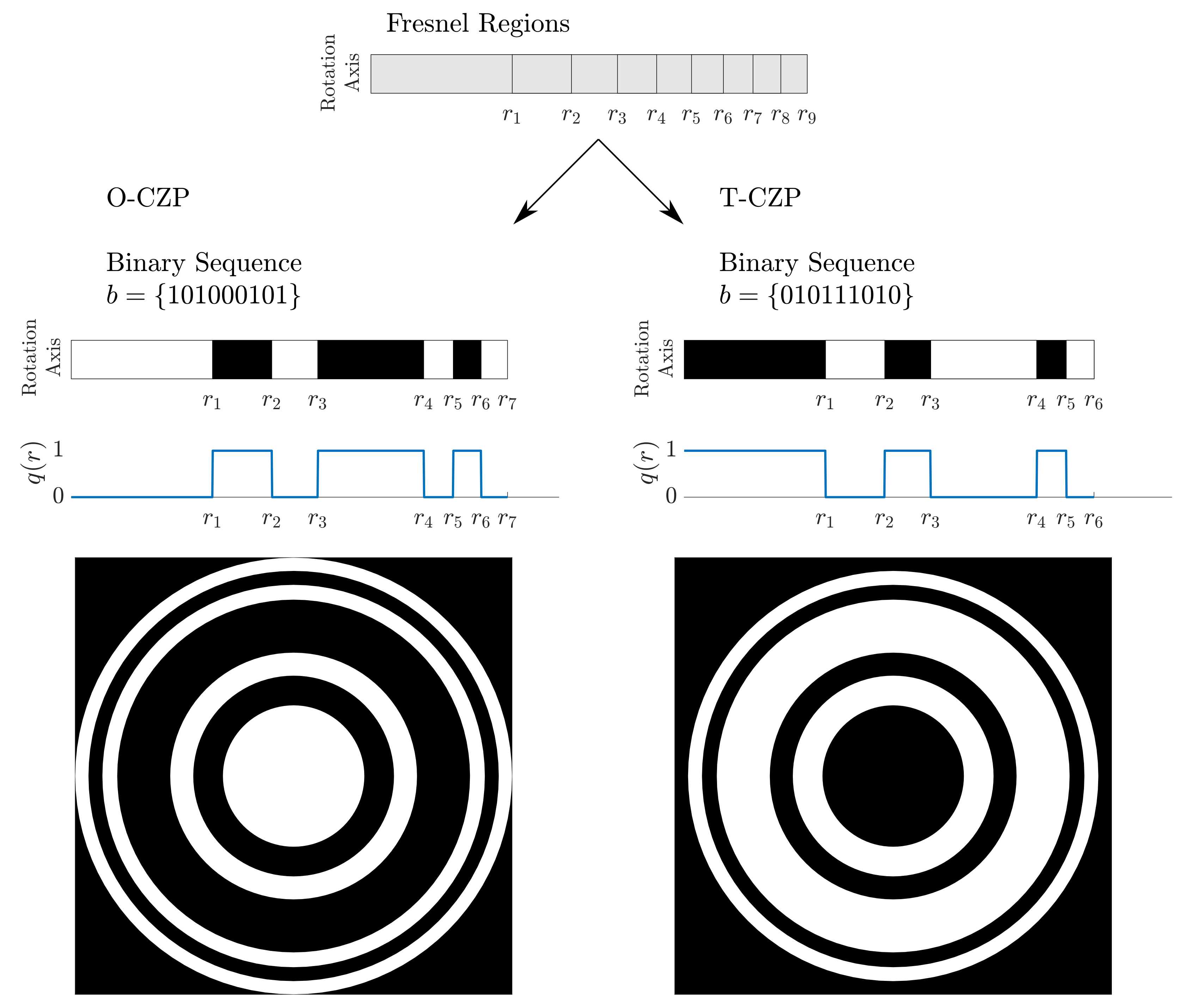
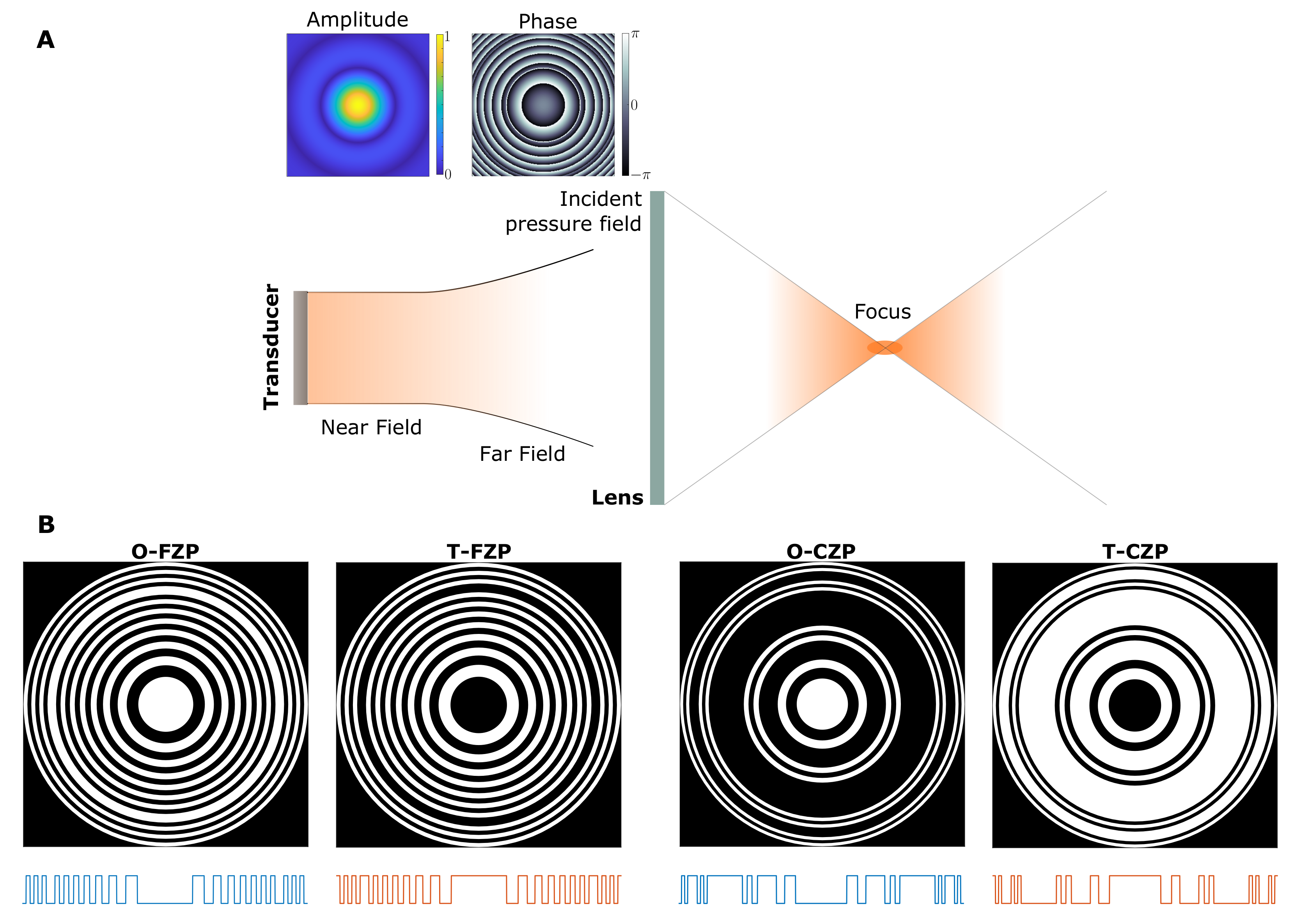
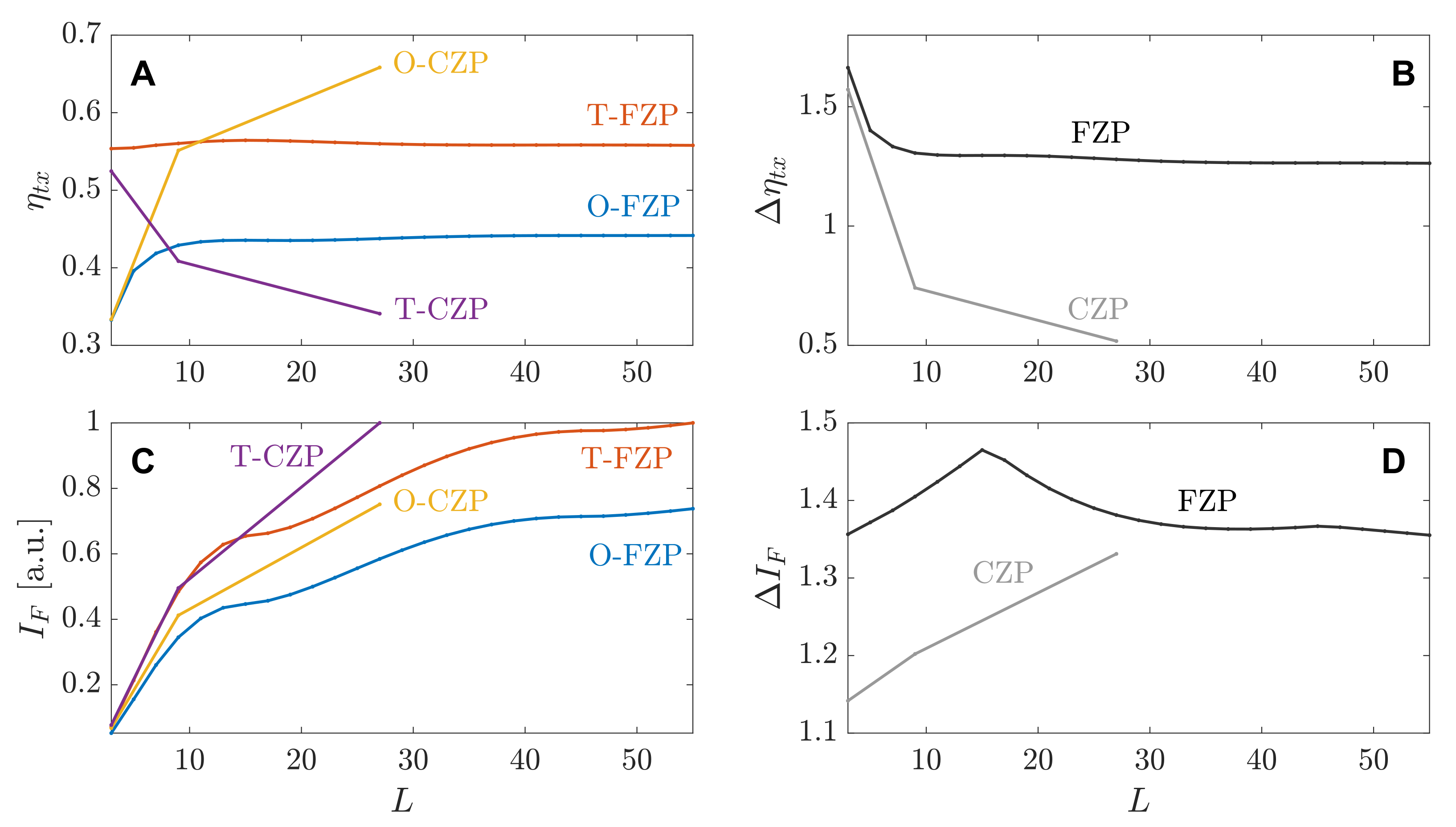
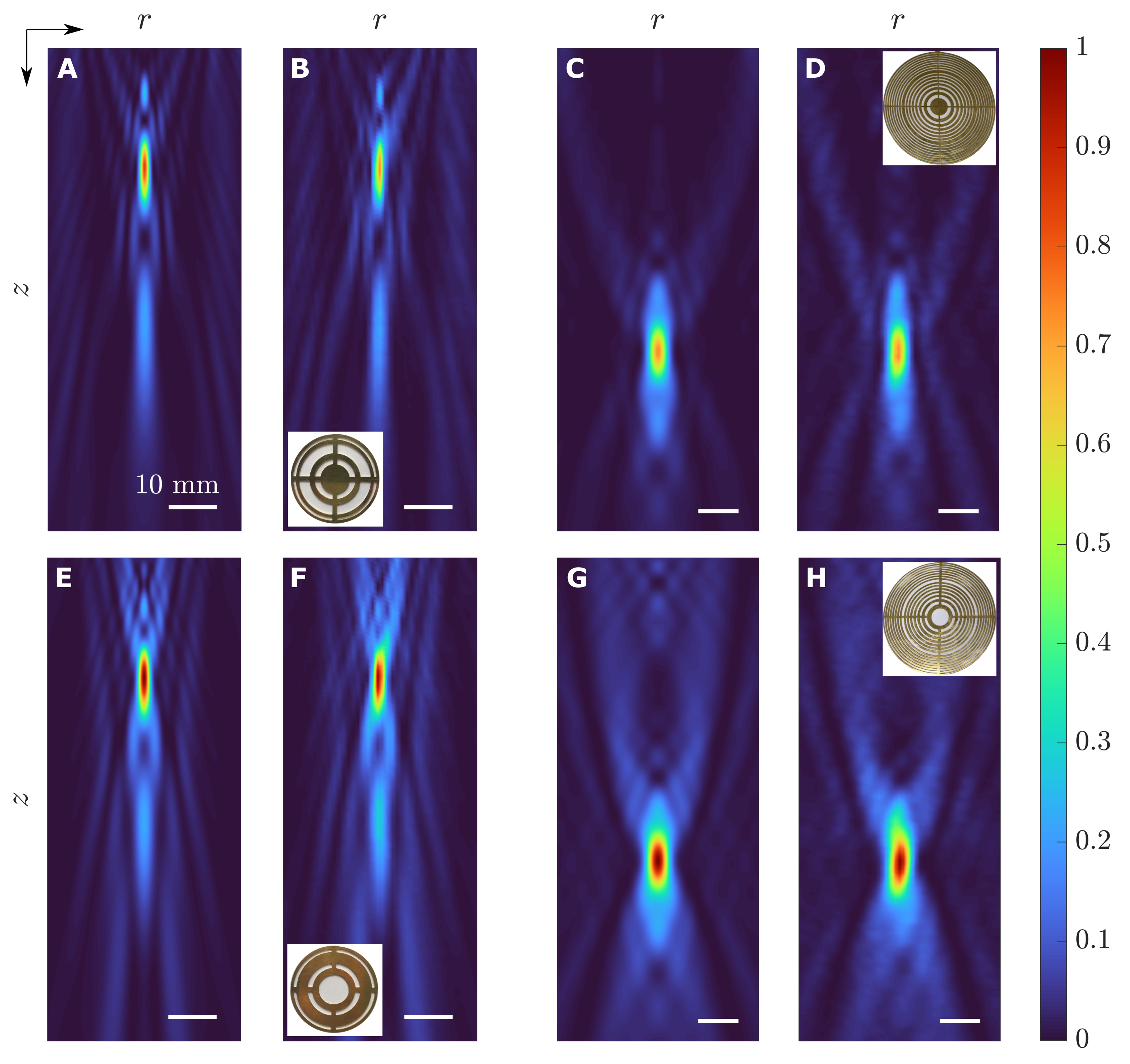
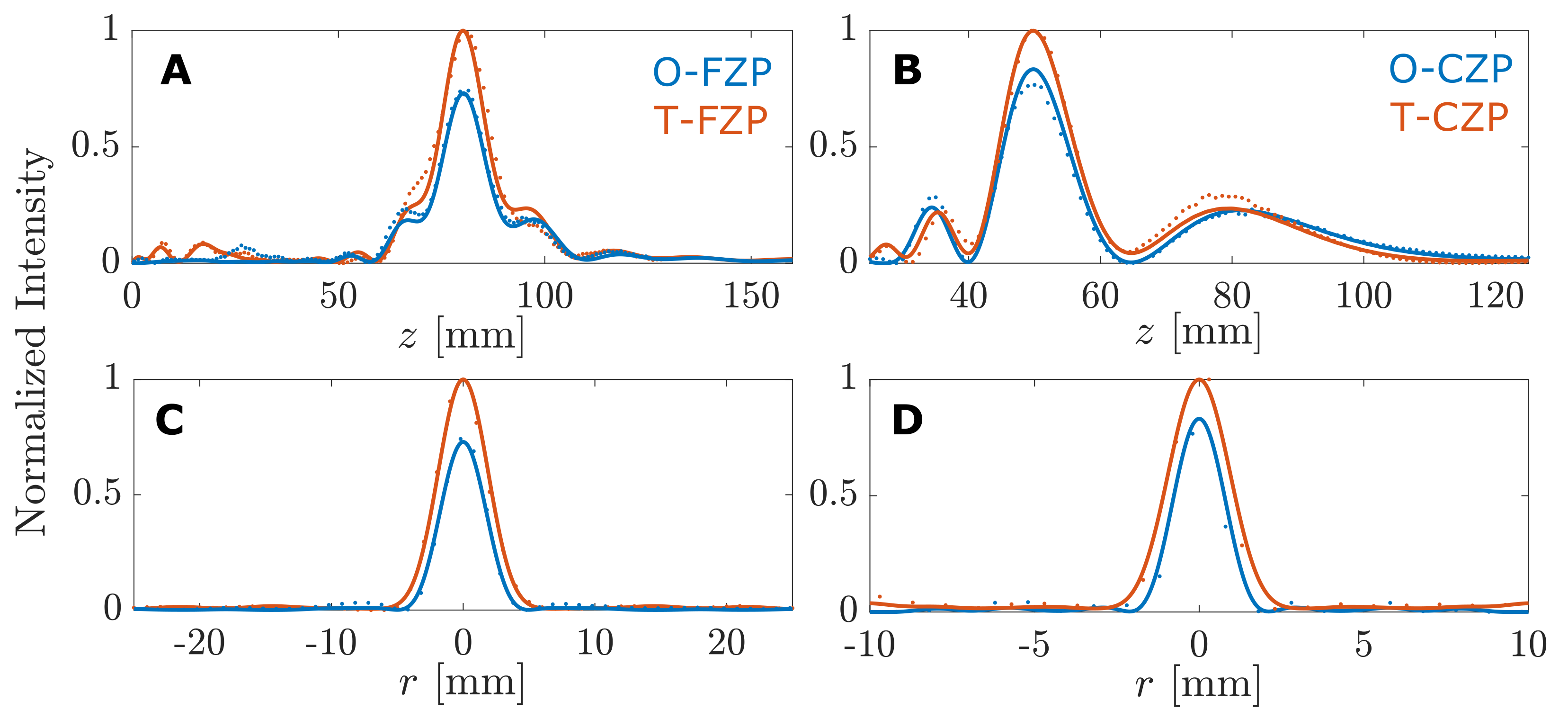
| S | L | Zone Plate | Binary Sequence |
|---|---|---|---|
| 1 | 3 | O-CZP | |
| T-CZP | |||
| O-FZP | |||
| T-FZP | |||
| 2 | 9 | O-CZP | |
| T-CZP | |||
| O-FZP | |||
| T-FZP | |||
| 3 | 27 | O-CZP | |
| T-CZP | |||
| O-FZP | |||
| T-FZP |
| Zone Plate | L | Binary Sequence |
|---|---|---|
| Fibonacci SZP | 21 | |
| Predistorted SZP | 19 | |
| Thue–Morse SZP | 16 |
| f (kHz) | F (mm) | FLHM (mm) | FWHM (mm) | ||
|---|---|---|---|---|---|
| O-FZP | 270 | 80 | 12.85 | 3.86 | 0.77 |
| T-FZP | 270 | 80 | 14.45 | 4.34 | 1.00 |
| O-CZP | 1000 | 50 | 11.48 | 1.59 | 0.74 |
| T-CZP | 1000 | 50 | 11.39 | 2.09 | 1.00 |
| FZP | 1.20 | 1.30 |
| CZP | 1.37 | 1.35 |
Publisher’s Note: MDPI stays neutral with regard to jurisdictional claims in published maps and institutional affiliations. |
© 2021 by the authors. Licensee MDPI, Basel, Switzerland. This article is an open access article distributed under the terms and conditions of the Creative Commons Attribution (CC BY) license (https://creativecommons.org/licenses/by/4.0/).
Share and Cite
Candelas, P.; Pérez-López, S.; Fuster, J.M. On the Design of Soret Zone Plates Based on Binary Sequences Using Directional Transducers. Sensors 2021, 21, 6086. https://doi.org/10.3390/s21186086
Candelas P, Pérez-López S, Fuster JM. On the Design of Soret Zone Plates Based on Binary Sequences Using Directional Transducers. Sensors. 2021; 21(18):6086. https://doi.org/10.3390/s21186086
Chicago/Turabian StyleCandelas, Pilar, Sergio Pérez-López, and José Miguel Fuster. 2021. "On the Design of Soret Zone Plates Based on Binary Sequences Using Directional Transducers" Sensors 21, no. 18: 6086. https://doi.org/10.3390/s21186086
APA StyleCandelas, P., Pérez-López, S., & Fuster, J. M. (2021). On the Design of Soret Zone Plates Based on Binary Sequences Using Directional Transducers. Sensors, 21(18), 6086. https://doi.org/10.3390/s21186086






